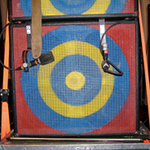Cindy Sherman
Cindy Sherman
Museum of Modern Art
11 West 53rd Street, New York, NY
February 26–June 11, 2012
If Cindy Sherman had disappeared from the art world after shooting the seventy Untitled Film Stills (1977–80), her first major series of photographs, she would have left behind one of the most conceptually astute, visually compelling bodies of work in twentieth-century art. She hasn’t stopped working, of course, and her Museum of Modern Art retrospective accelerates the notion that this longtime New Yorker deserves a place in the pantheon of modern greats, joining Picasso, Duchamp, Pollock, and Warhol.
From the Untitled Film Stills, for which the artist typecast herself as various female cinematic types (Hitchcock blonde, Godardian babe, femme fatale, girl next door), to the more recent Society Portraits, whose women sport delightfully atrocious fake tans and botched facelifts, Sherman has driven a singular idea—vamping in costume and makeup amid elaborate backdrops and props—into a career that encapsulates countless feminist, aesthetic, and psychoanalytic theories. However much her work may express ideas from, say, Laura Mulvey’s famous essay on the male gaze, “Visual Pleasure and Narrative Cinema,” it does much more than simply illustrate scholarship. One of Sherman’s greatest qualities is the way her subject matter brims with potential meaning. Anyone with a cursory knowledge of art history, critical theory, or popular culture can produce sophisticated interpretations. And yet her photographs are so smart and complex on their own that they transcend theory—which is why it’s disheartening that, as an exhibition, Cindy Sherman falls short.
The show’s faults, though, come from the curators. Avoiding an overly strict chronological approach, Eva Respini and Lucy Gallun superbly install thirty-five years of work in rooms that collect discrete series: twelve Centerfolds (1981) commissioned but ultimately rejected by Artforum; numerous History Portraits (1989–90), hung salon style, that caricature the old masters; a dynamite 2000 series of soccer moms, aging bimbos, executive types, and ladies who lunch. But attempts at thematic clusters, cherry-picked from different parts of Sherman’s oeuvre, barely hold together, especially the gallery focusing on, quite flatly, group compositions. Dispersions of Clowns (2003–4) across the exhibition diminish their frightening aspects and rein in Sherman’s theatrical tendencies.
The curators all but ignore eight years of work—only three photos here were made after 1992 and before 2000—a move that skips over, for example, the artist’s fascinating series of masks from this period. They also downplay the gruesome Disasters and odious Sex Pictures from the late 1980s and early 1990s, which cry for the dim lights and dark walls afforded to the History Portraits. (To their credit, Respini and Gallun include the most abject images from these series, such as the double-crotch mannequin with shriveled penis and bushy vulva sprouting a tampon string.)
With over 170 pictures, there’s much to like. If you find the Untitled Film Stills to be too white, educated, and middle class, delight in (or recoil from) the vomit splatter of Untitled #175 (1987) or poke fun at the fortysomething socialites clutching red Solo party cups in Untitled #463 (2007–8). On the whole, while Sherman’s work is stellar and its place in art history incontestable, MoMA’s presentation is surprisingly, but far from ultimately, less than satisfying.
Originally published as “Cindy of a Thousand Lives” in the L Magazine on March 28, 2012.

